Research documenting rare bindery dust jackets from the eighteenth to the twentieth centuries. Adapted from the Spring 2019 Journal of The Private Libraries Association, Pinner, Middlesex, England. Reprinted by permission.
The practice of issuing dust jackets on new books is generally thought to have begun with the introduction of publishers’ bindings around 1820. Books issued before then (and after) in provisional bindings are believed to have neither needed nor received jackets.1 But while this understanding of early jacket use has long seemed correct for British, American and European books, recently examined evidence shows that dust jackets were issued long before the 1820s in the German states and probably elsewhere in Europe. Most of the surviving examples of these jackets, including the earliest ones, are of German origin, which is where this previously undocumented and all but unknown chapter of book history begins.
I. Two-piece bindery jackets 1760s–1860s
Throughout the latter decades of the eighteenth century and beyond, German binderies produced a distinctive and durable type of dust jacket for the simple board bindings of that period. This practice continued well into the era of publishers’ bindings in the nineteenth century. Examples of these jackets have been examined on about thirty titles, all bound in paper-covered boards, from the 1760s to the 1860s.2
These early jackets had several characteristics that were common to them throughout the entire period of their use. They were nearly all made from two sheets of paper pasted together. The outer sheets were either marbled paper, paste paper or plain paper. The bottom sheets, or underlayer, added for reinforcement, were usually a piece of printed waste, most often dead quire stock, sometimes a leaf of manuscript, occasionally just plain paper.
The jackets all had from six to twelve flaps, always including French flaps (three flaps) at each end. Often there were two additional central flaps that folded inside the top and bottom of the backstrip, and sometimes four small auxiliary flaps that were fashioned at the ends of the fore-edge flaps. These auxiliary flaps folded between the boards and jacket panels, creating an interlocking effect that made the jackets difficult to remove. In some cases, the corners of the French flaps were pasted to each other where they overlapped, making it even harder to remove the jackets.
These unusual efforts to keep the jackets on the books account in part for the large number that have survived. Their durable two-piece construction also aided survival. Although the jackets range in age from about 150 to 250 years old, many of them are in remarkably complete condition, unlike later single-sheet jackets which were more susceptible to tearing, chipping, separation, disintegration and loss.
The bindings over which these jackets were issued were the standard German gebrochener Rücken (broken back) boards of the period, the three-piece adhesive case bindings that were produced in large quantities in the eighteenth century and beyond.3 These bindings were usually covered with paste paper, marbled paper or plain colored paper—just like the dust jackets that are found on some of them.
Although these bindings were relatively plain, they usually received some finishing. All of the examined jacketed bindings had trimmed edges, usually colored red. Many had woven headbands. Some had leather spine labels stamped in gilt, or printed paper labels. Most of the bindings, however, had either primitive handwritten labels, blank labels or none at all, as if awaiting a purchaser’s decision as to whether to keep or replace the boards with custom work. In many instances, it was the dust jackets alone that provided the only exterior identification for these books on their own spine labels, which were almost always handwritten as well.
The presence of some finishing and even dust jackets suggest that these bindings were considered more than temporary. While many of the boards were undoubtedly replaced with custom bindings, thousands have survived in their original state. Colorful, durable and cheap, they seem to have been a popular retail binding.
To the inevitable question of whether the dust jackets found on some of these books were of bindery origin or were homemade, several factors collectively demonstrate that they were bindery work. One is that the outer paper of the jackets and the paper covering the boards often matched, indicating that the boards and jackets were made in tandem. Another is that printed waste from other binding jobs was so often used as the bottom sheet or underlayer for the jackets. Also, the uniform cut and fold of the jackets—clearly and consistently superior to homemade jackets—indicates professional construction. Even the remarkably unworn condition of the bindings demonstrates protection since new. And the fact that these jackets all shared the same distinct characteristics—the same materials, form, and quality of workmanship over a century or more of production—indicates that they were not the work of individual book owners fashioning their own dust jackets independently of each other.
Even if book owners had all somehow managed to produce exactly the same type of two-piece jackets for 100 years, the odds that all those jackets would have been used only (or even chiefly) to protect plain board bindings are remote, to say the least. The clear and long-standing link between this type of jacket and that one type of binding can only be plausibly explained as an industry practice.
Even the labels on the jackets indicate bindery origin. They are invariably like the binding labels—rectangular or square cut, sometimes with beveled corners, almost always with script titling. When both the jackets and the bindings have hand-lettered labels, the writing matches, and even when there are no labels on the bindings, their presence only on the jackets indicates coordinated production.4
It is also clear that these jackets were not the product of just one bindery, nor were they produced as custom orders for just one customer or library. The thirty or so examined titles had many different original owners, and the books were published in cities all over the German states, including Stuttgart, Leipzig, Düsseldorf, Frankfurt, München, Göttingen, Karlsruhe, Breslau and Berlin. Another three were published in Paris and one in Zürich. Thus, the books would have been bound and jacketed at many different binderies as well. Some of these books may have been part of custom orders—this was still an age when many books were sold in sheets, after all—but many of them seem to have been bound and jacketed in this form for the retail market.
The earliest German bindery jacket recorded to date is on a copy of Methodus Doctrinae Medicae (1766, checklist no. 1). This book was bound in thin boards covered with plain green paper, with a leather spine label, trimmed edges and woven headbands. The jacket’s outer paper was the same green paper as the binding, and its underlayer was the same laid white paper as the endpapers—clearly a jacket and binding made in tandem. The jacket had ten flaps and a rectangular cut in the spine to let the gilt title show through. The jacket papers were deckle-edged, with the white overlapping the green, creating an attractive fringed effect and indicating that an experienced, professional hand made the jacket. A dated owner signature (‘Planck 1777’) on the front endpaper shows that the book was bound and jacketed by that year.
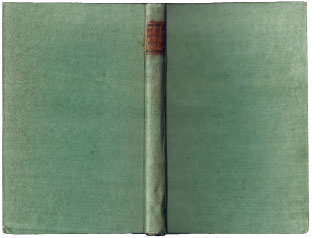
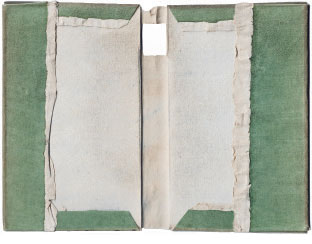
Methodus Doctrinae Medicae (1766).
Another title from Planck’s library, Institutiones Medicinae Clinicae (1769, no. 2), had the same green boards and jacket, the same leather label, trimmed edges, woven headbands and dated owner signature. The only difference was that this jacket’s underlayer, instead of plain paper, was a printed sheet from a 1771 book published in Leipzig, as were Planck’s volumes. All three books would have come from the same bindery, where leftover sheets from one binding job could be used in jacketing another. The binding and jacketing of the 1769 book occurred between the 1771 date of the printed waste and the 1777 owner date.
Whether Planck bought these books already bound and jacketed, presumably at the order of a bookseller, or bought sheets and ordered the work himself, the bindery origin of the jackets is clear. The bindery might even have added jackets on its own initiative to protect its work, without Planck or a bookseller specifying them.
Another book bound and jacketed remarkably like Planck's, although not from that library, was a German literary anthology, Hallers Schriften (1779, no. 3). This book also had green boards, a leather label, red trimmed edges, woven headbands and a matching green jacket with spine cut-out. Yet despite its striking similarities, this book was issued by a different publisher from a different city and was very likely the product of a different bindery in addition to having a different owner. Green was a common color for German boards, as were blue and gray and the various shades of marbled and paste papers. The jacket had a full complement of twelve flaps, which completely protected all sides, edges and corners of the boards, which remain virtually unworn today.
Another title in green boards, Geschichte des Klosters Hirschau in dem Herzogthum Wirtemberg (1782, no. 4), had a blank spine label, while its jacket (orange paste paper over Latin manuscript scrap) had a handwritten label. Each label was cut into the shape of a shield or chevron, another indicator of binding and jacketing with the same origin. This book’s owner signed the front endpaper "Köhler. J. C. 1790."
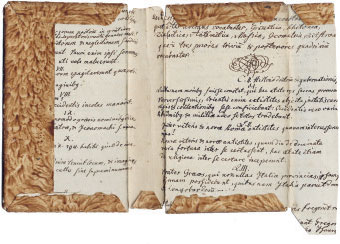
Geschichte des Klosters Hirschau in dem Herzogthum Wirtemberg (1782), showing lower central flap (upper torn away) and two auxiliary flaps at ends of fore-edge flap.
A Swiss book, Anleitung für das Landvolk in Absicht auf seine Gesundheit (1778, no. 5), was decoratively bound in white half-paper vellum with red, white and blue marbled boards, trimmed edges and woven headbands. Yet despite its attractive color and finishing, this binding had no exterior title or label. Only the black paste paper jacket (with Latin manuscript underlayer) had a handwritten label. The owner of the book was named "Magenau."
Two British theological works translated to German, Zungen-Zaum oder Gründlicher Unterricht von Christlicher Regierung der Zunge (1727) [with] Abhandlung von den Versammlungen der Christen zum öffentlichen Gottesdienst (1747, no. 6), were bound in one volume with plain brown boards and a plain gray jacket. The jacket was underlaid with a waste sheet whose one-sided printing was pasted face down. The binding and jacketing occurred between 1747 and 1802, the date of the ownership signature of M[agister]. P. H. Elsner.
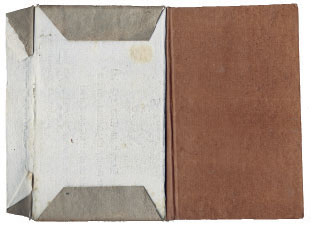
Zungen-Zaum ... (1727-47) showing auxiliary flaps at end of fore-edge flap.
The dust jacket for Die Feyer der Liebe (1795, no. 6a) remains fully sealed 227 years after the bindery glued its French flaps to each other where they overlap. This practice encapsulated the binding within the jacket while leaving the text block exposed so that the book could be opened. Just enough of the binding is visible at the top and bottom of the backstrip to identify it as the common green boards, virtually all of which has been unseen and untouched since the eighteenth century. Similar practices of sealing bindings within their jackets occurred in various forms in other countries in later years.5

Die Feyer der Liebe (1795)
Three French titles are currently recorded with two-piece bindery jackets over cased boards, although it is not certain that these books were bound and jacketed in France. One is a copy of De l’Education des Filles (1800, no. 7) in plain gray boards. The outer jacket paper was the same gray paper as the binding, and was underlaid with printed waste from a French periodical, Journal Politique de l’Europe (1799). Like many German examples, the binding had no exterior identification; the jacket alone carried the title on a handwritten label. And the jacket’s French flaps were pasted to each other where they overlapped, again like some German examples. Thus, while the binding and jacketing resemble German work, the jacket’s underlayer suggests French origin.
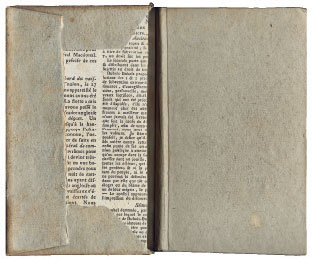
De l’Education des Filles (1800).
A pair of French medical books, Traité de Matière Médicale (1809, no. 8) and Manuel Médical (1809, no. 9), had matching bindings of orange paste paper boards, and jackets of matching gray paper (faded brown). The bottom sheet for each jacket was German manuscript scrap. The bindings had the usual trim but no exterior titles or labels. The jackets had matching spine labels written in French. Each volume had the bookplate of Professor J. C. G. Reuss, a German physician and author.
As with Planck’s books from the 1760s, one can speculate whether Professor Reuss bought these books already bound and jacketed, or bought sheets and ordered the work himself. If Reuss ordered the work, he presumably would not have left the bindings blank but would have specified permanent labels for them. A bookseller, on the other hand, whether French or German, might well have ordered unlabeled cheap matching bindings for titles from the same genre, with cheaply labeled jackets for interim protection and identification, leaving the choice of finish labels (or new bindings altogether) to the purchaser. Professor Reuss may have retained these jackets simply because they had the only exterior titles. The books seem largely unused.
Remarkably, another French book with a much earlier jacket is known. It predates the earliest recorded German bindery jackets by more than two centuries. A copy of Strabo’s classic Geographica (1559)6 was bound in limp parchment and protected with a jacket constructed remarkably like the later bindery jackets. It had French flaps, was made of the same parchment as the binding, and was underlaid with manuscript scrap. Whether it was produced with the binding or added later, it was clearly contemporary. It shows that jacketing existed by the sixteenth century and that manuscript waste had been employed in jacket construction by then. Such waste had long been used as filler material in bindings and to make endpapers and bound wraps for some books, so it was natural that manuscript waste, and printed waste, would have appeared in dust jackets as well.
Several more German titles with two-piece jackets over board bindings have been examined from the eighteenth century, and nearly two dozen from the nineteenth, including a twelve-volume history, Karl Friedrich Becker’s Weltgeschichte (1824–7, no. 10), which has surviving jackets on ten volumes. These jackets were made from the same orange paste paper as the boards, with bottom sheets of printed waste or manuscript scrap. All the jackets had the usual handwritten spine labels, the bindings blank labels or none.
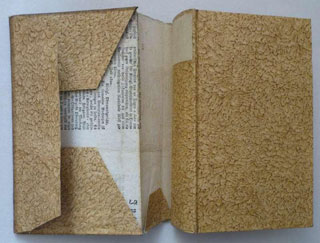
One of 12 vols. from Becker's Weltgeschichte (1824-7). The upper central jacket flap was torn away and remains inside the backstrip, a common occurrence.
An account of the Peloponnesian War, Geschichte des Peloponnesischen Krieges (1827, no. 11), was bound in the common green boards with a jacket of equally common black paste paper over a printed sheet of Le Beau Monde from 1828. Another book, Erklärung des anatomischen Atlasses ([1835], no. 12), was bound in black paste paper boards with a matching jacket underlaid with a sheet of publisher’s advertisements from the 1830s. Only the jacket carried a title, or even a label.
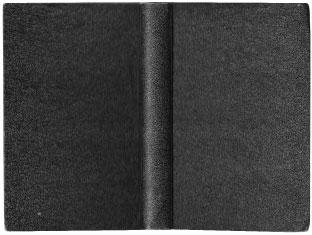
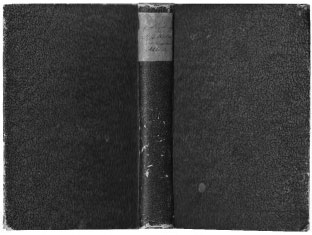
Erklärung des anatomischen Atlasses (1835).
An exception to the two-piece format was the jacket on Entwurf und Vorschlag zu einer Apotheker-Ordnung (1830, no. 13). This jacket was made from just a single sheet of plain blue-gray paper with no underlayer, but with all the other attributes of two-piece jackets. It was uniformly cut and folded with eight flaps and had a handwritten spine label. The matching blue-gray plain board binding had a matching blank label and remains entirely unworn, indicating protection since new. The book was from the Fürstenberg Library in Donaueschingen, with its stamps.
It probably was not unusual for some of the early bindery jackets to be made from single sheets, especially by the 1820s. Single-sheet jackets were beginning to appear on publishers’ bindings by then and were easier to produce than the two-piece type.
Several other examples of two-piece bindery jackets are recorded from the 1840s and 1850s, but only one after that. The evident decline in the use of these jackets after the middle of the nineteenth century probably coincided with a declining market for the plain board bindings they covered. These boards had filled a niche in the German marketplace for cheap, functional bindings since early in the eighteenth century, and the demand for them had lasted well into the era of publishers’ bindings in the nineteenth. But, by the 1850s and 1860s, the more decorative new bindings of stamped cloth, embossed leather and illustrated boards had largely taken over the marketplace, along with the single-sheet dust jackets that increasingly covered them. Single-sheet jackets were more versatile than the two-piece type and could be specifically printed for books. They were much more suited to the mechanized world of large-scale edition binding than two-piece jackets made by hand.
During the century or more that two-piece jackets were produced for board bindings, the jackets seem never to have evolved beyond their original protective role.7 Other than carrying a handwritten title, they are not known to have had a formal marketing function such as carrying printed advertising, although their presence on bindings may have been considered a marketing feature itself—offering extra value, protection and durability for the money—akin to the slipcases that protected pocket annuals and almanacs of that era.
Aesthetically, the two-piece jackets had no role other than sometimes matching the appearance of the binding they covered. The jackets fitted the books so snugly and covered them so completely that they looked like bindings on the shelf. The cheap, primitive-looking labels that were always on the jackets (except those with spine cut-outs) and often on the bindings added to the look-alike effect, but appearances apparently mattered less to purchasers of these books than low-cost functionality and sturdy, long-term protection.
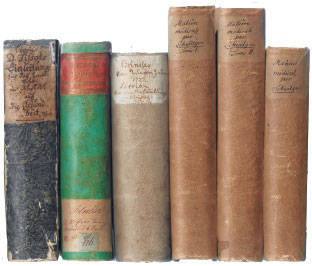
Two-piece bindery jackets over board bindings: Swiss (1778), German (1779), German translation of British (1747-1802), and two French titles (1809).
German book publishing in general seems to have been far ahead of other countries in the use of dust jackets and other types of exterior book protection throughout this period. German jackets of the eighteenth and nineteenth centuries survive in far greater numbers than they do on books from any other country. For example, during the first three decades of publishers’ bindings (1820–50), of the twenty or so titles from all countries that are currently recorded with surviving jackets over publishers’ bindings, three-quarters of them are German.8 German jackets also survive in significantly higher numbers throughout the rest of the nineteenth century.9 Slipcases too are much more commonly found on eighteenth- and nineteenth-century German annuals and almanacs than on their British or American counterparts, and German firms even produced loose printed paper full wrappings and cardboard portfolios to protect and identify unbound sheets, a type of formal protection for sheets undocumented anywhere else.10 German hymnals and autograph albums of this period also are commonly found with dust jackets and matching slipcases of bindery origin.
Higher survival rates of German jackets and boxes presumably reflect higher production rates. It is also likely that German booksellers and customers simply saved dust jackets and slipcases more often than was done elsewhere, perhaps a reflection of German culture. However it happened, the considerably higher German survival rates are all the more remarkable considering the vast destruction that occurred in that country during the Second World War.
Establishing the clear bindery origin of two-piece jackets pushes back the date of recorded jacketing on new books by over half a century, at least in the German states, for the first time placing such work in the eighteenth century, long before the era of modern publishing practices and the issue of jackets on edition-bound books. Remaining issues include verifying whether France and other European countries also produced these jackets, as seems likely, establishing how early and how late such jackets were in use, and perhaps getting a better sense of how often jacketed volumes of this type appeared in eighteenth- and early nineteenth-century European bookshops. Additional examples may provide some answers—at least to the extent that such questions can be answered.
But the bindery origin of the two-piece jackets is clear. That origin is further confirmed by the continued practice of binderies of making dust jackets from scrap paper through the nineteenth century and into the twentieth. These later bindery jackets were made from single sheets of printed waste for bindings of publishers' cloth.
II. Single-sheet printed waste jackets 1850s–1920s
As publishers’ bindings became common in the nineteenth century, so did the single-sheet dust jackets that increasingly covered them, especially as the new bindings became ever more decorative in the decades after their introduction around 1820.
But while the development and application of single-sheet jackets grew throughout the nineteenth century, the use of specifically printed jackets was never universal, not even toward the end of the century. On the many occasions when publishers did not supply binderies with specifically printed jackets, the binderies often made their own from plain paper, sometimes with spine cutouts to let the title show through. Such jackets were widely used by binderies in many countries, and although they did not survive in large numbers, they are common enough today that their use is well documented.11
In recent years, evidence has emerged to show that nineteenth- and twentieth-century binderies also made dust jackets for publishers’ bindings from printed waste. Like the earlier two-piece jackets that used waste paper for underlayer, these later printed waste jackets are virtually unknown and undocumented today. They were made during the second half of the nineteenth century (and probably earlier), and continued in use well into the twentieth century.
There were several ways in which these later bindery jackets differed from or resembled the earlier ones. The biggest difference is that they were made just from single sheets of printed waste with no outer layer covering them. They also had just one flap at each end. And the waste paper that was used for all recorded examples of these jackets was dead quire stock (no manuscript scrap as was often used with the two-piece jackets). The later jackets, like the earlier ones, were always uniformly cut and folded, indicating professional construction, and the bindings they covered were preserved in essentially new condition, showing that they had been protected from the very beginning of their existence. Such factors again collectively demonstrate the bindery origin of these jackets.
Their rarity today is probably due to their having been almost universally discarded at the retail level. Few booksellers would have put books out for sale that were jacketed in printed waste from unrelated books, and, even if they did, customers would not have kept them. The few examples that have survived are on books that never left storage or, at any rate, on books that were never offered for sale. About a dozen titles are currently recorded with single-sheet bindery jackets made from printed waste, all of them on bindings of publishers’ cloth issued between 1855 and 1920. All but one of these books are British, with just one American title recorded so far with printed waste jackets, and none from Germany or other countries.
Most of these jackets came to light after the closing of the venerable Tulkens bookshop in Brussels, Belgium, in 2008. This celebrated shop, opened by A. Louis Meuleneere in 1848, had tens of thousands of books in storage when it closed. Many of these books were a century or more old but were still in new condition because they had never been put out for sale. They had been stored since new on the upper floors of the shop’s four-story eighteenth-century townhouse. Thousands of these books were still wrapped or jacketed just as they had arrived from binderies in the nineteenth or early twentieth centuries.
The dust jackets found at Tulkens included many specifically printed publishers’ jackets (some dating to the 1880s), as well as bindery jackets made from plain paper or from printed waste. Some books even had sealed wrapping jackets that fully enclosed the books and were sealed shut. This was another type of jacket that almost never survived.12
The earliest title currently recorded with single-sheet printed waste jackets is Ancient Armour and Weapons in Europe (1855, checklist no. 14). About six copies of this well-known British work were stored at Tulkens, all still in new condition with identical jackets. The books were bound by Burn & Co. of London, and the jackets were made from leftover sheets of another book bound by Burn. As with other examples, it was this joint bindery connection which enabled leftover sheets from one binding job to be used in jacketing another.
Another British example was Book-Plates (1897, no. 15). At least two copies stored at Tulkens (the shop bought many titles in multiples) had jackets made from discard sheets of Angelica Kauffmann (1893). Both titles were published in London and again would have shared the same bindery.

Book-Plates (1897).
A group of nine annual volumes of the British auction reference, Book-Prices Current, dating from 1897 to 1914 (no. 16), had printed waste jackets on eight volumes. All eight jackets were made from sheets of the same book, The Old Missionary (1897). For these eight volumes issued over a period of seventeen years to have all received the same waste paper jackets, the books must have been ordered and jacketed together, rather than being purchased separately year by year. They may have been bound together too, since the bindings all have the publisher’s later state black lettering.
Duplication of jacket sheets was very common. In every example recorded to date, both on books found at Tulkens and elsewhere, when multiple copies of the same title had printed waste jackets, the jackets were all made from sheets of the same book, often from the same pages. The bindery scrap piles from which jacket paper was taken contained reams of duplicate sheets from many books.
Many A. & C. Black color plate books were stored at Tulkens, all still in fine unused condition. Many had specifically printed publisher’s jackets; others had bindery jackets made of printed waste. Examples of the latter include four copies of Switzerland (1917, no. 17), with jackets all made from leftover sheets of an unidentified book or periodical about Scotland. Another example, Belgium (1920, no. 18), was jacketed in a sheet from Border Ghost Stories (1919).
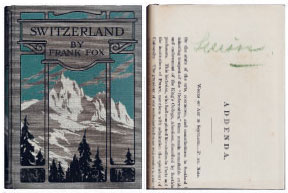
Switzerland (1917).
Several factors would have influenced the decisions made by publishers and binders regarding whether and when to issue books with either specifically printed or generic jackets. One factor was cost. It was less expensive to make unprinted jackets from cheap plain paper at the bindery than it was to have jackets printed and delivered there. Even cheaper than plain paper was the free printed waste that all binderies had in abundance.
Another factor was supply. Some of the later use of printed waste for jacketing in Great Britain, such as the A. & C. Black examples from 1917 and 1920, was probably caused by paper shortages during and after the First World War. 13
.jpg)
Belgium (1920).
Another influence on jacketing was whether the book in question was a first edition or a reprint. There are numerous examples of nineteenth century first editions issued with specifically printed jackets, while their reprints had bindery jackets made of plain paper or printed waste. In the era before specifically printed jackets became virtually universal for all editions of books, some publishers evidently felt that printed jackets were useful to help launch a new work, while bindery jackets were good enough to protect later printings.14
The tastes and preferences of individual publishing houses and their binderies no doubt varied as well—some firms might have used printed waste jackets often, others never. Timing would have mattered too. Whatever jackets were used when the first part of an edition was bound might have been gone by the time remaining sheets were bound at a later date, leaving binderies to make new jackets of plain or waste paper.
There probably also were occasions when binderies simply ran out of printed jackets while binding was in progress and had to jacket remaining copies with whatever paper was available. The alternative was to set the books aside and wait until new jackets could be printed and delivered, possibly causing publishing dates and shipping deadlines to be missed.15
One example of running out of jackets evidently occurred with the jacketing of a set of Windsor Castle: An Architectural History (1913, no. 19). This famous British work was issued in two massive volumes of text, along with a folio volume of plates and plans, in 1,050 numbered sets. The books were bound either in half-vellum or in red cloth. An unnumbered set bound in red cloth and stored since new at Tulkens had its text volumes jacketed (quite strikingly) in printed waste from another book published in London that year, The Russian Ballet (1913). The numbered sets presumably had specifically printed jackets or at least neutral plain ones, as did nearly all books by 1913, especially elaborate and expensive productions like this. The bindery had apparently run out of whatever jackets it had used for the numbered sets by the time the unnumbered sets were bound.
Several British titles published by Kegan Paul were found with printed waste jackets at Tulkens, including Men and Women of the French Revolution (1906, no. 20). Its jacket was made from a discard sheet of a book published seventeen years earlier, Notes on Sport and Ornithology (1889). Many printed waste jackets date from within a year or two (before or after) of the book being covered. But some of the jackets are significantly older or newer. In the case of older jackets, this occurred when leftover sheets from binding jobs were thrown onto bindery scrap piles and then buried under leftover sheets from subsequent jobs. The older sheets might not re-emerge again for years. Newer jackets resulted when books were not bound or jacketed for years after publication. The jackets on the half-dozen Tulkens copies of Ancient Armour and Weapons in Europe (1855) were made from 1869 sheets.
To date, just one British title which was not from Tulkens has been located with printed waste jackets. Memoirs of a Highland Lady (1897, no. 21) was bound in red cloth with a paper spine label. Its publisher was R. & R. Clark of Edinburgh. About a dozen copies of this book, all with printed waste jackets, were owned by the editor of the book, Lady Strachey (perhaps remainders or complimentary copies). The waste sheets used for the jackets were from an 1897 periodical which Clark also published.16
The only American title that has so far come to light with printed waste jackets is Good Talking and Good Manners (1887, no. 22), a collection of sermons published in Syracuse, New York. Three copies of this book, all in fine unused condition, were found in the attic of an old church in Syracuse, perhaps meant for parishioners but never distributed. Each copy had a jacket made from a sheet of an American edition of Charles Kingsley’s Hypatia (1878). In the same attic were four equally fine copies of Family Prayers for Morning and Evening (1890, no. 23), also issued by the same Syracuse publisher. One of these books had a plain bindery jacket. Thus, these two titles that had been in storage since new retained the two types of dust jackets that binderies are known to have produced—made either from plain paper or from printed waste. It is possible that jackets made from printed waste were more common in the nineteenth century than jackets made from plain paper, although they survived far less often. The printed waste was free; the plain paper had to be purchased.
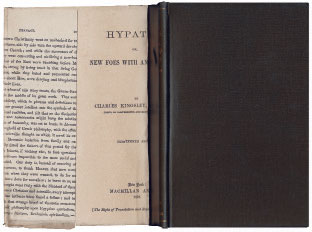
Good Talking and Good Manners (1887).
Another kind of book protection that binderies must have used quite often was the simplest and cheapest of all—this was to wrap books fully in printed waste or plain paper. Thousands of books stored at Tulkens were fully and loosely wrapped in this way. The printed waste used for this purpose was either contemporary newsprint, magazine leaves or, again, old quire stock.
Binderies probably fully wrapped books (and unbound sheets) in waste paper for centuries, especially before dust jackets came into common use. Such wrapping would have been removed before the books were put out for sale, so that the only way this paper might have survived was on books that never went on sale.
Examples of fully wrapped books at Tulkens included many German and French books. About eighty of them have been examined. In virtually every case, the printed waste was from the same country as the book it covered—i.e. the German books were wrapped in German paper and the French books in French paper. The consistent matching of the books and paper was one indication of bindery origin. Another was that only on British books in storage at Tulkens was the printed waste (from Britain) cut into dust jacket form rather than being fully wrapped. Had the Tulkens shop done this work, it surely would have fully wrapped all books, regardless of country. And while newsprint and magazine waste from France, Germany and Britain would have been readily available in a cosmopolitan city like Brussels, discard quire sheets from those countries probably would not. Clearly, much of the wrapping and jacketing (with some exceptions) was done by the binderies in each country, using their own native waste and based on their own customs and practices for protecting books.
One large example of native German wrapping found at Tulkens was a group of forty-two hardcover books (six titles) issued by Hugo Schmidt Verlag in München during the First World War, including Ludwig Richters Heimat und Volk ([1917], no. 24). Each book was fully wrapped in contemporary German quire stock or magazine scrap, another apparent example of resorting to printed waste during wartime paper shortages. Each sheet was hand-stamped with the book’s title.
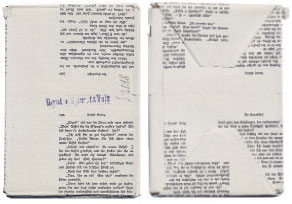
Ludwig Richters Heimat und Volk [1917].
Some French books stored since new at Tulkens retained various kinds of formal sealed wrappings. These included semi-transparent waxed paper wrappings that fully enclosed the books, and others that wrapped the books but left the top and bottom of the text block exposed. Some books were fully sealed in plain brown bindery paper with publishers’ labels on the sides. As with so much else at Tulkens, such wrappings almost never survived anywhere else.
The Tulkens stock was a priceless treasure, possibly the last of its kind. Reportedly over 100,000 volumes, this vast time capsule of books stored since new showed how books were protected and delivered to bookshops in the nineteenth and early twentieth centuries. The Tulkens stock had every kind of book wrapping and jacketing known to have been used by publishers and binders—specifically printed jackets, bindery jackets made from plain paper or from printed waste, and sealed or loose overall wrappings.
Regretfully, although all of this paper had survived for over a century and two world wars, not all of it survived the shop’s closing. The dealers who bought up the stock after 2008 naturally saved all of the specifically printed publishers' dust jackets. But many bindery jackets and wrappings made from printed waste were discarded under the assumption that they were later additions to the books that had no historical significance or monetary value. Many of these jackets and wrappings were reportedly covered with soot, adding to their valueless appearance. Some of the overall wrappings were not original—they had been added later at the shop (for example, books from the 1920s wrapped in newsprint from the 1960s).17 But many overall wrappings were original, as were all of the printed waste dust jackets made for British books. The wholesale disposal of thousands of these wrappings and jackets was a tragic loss.
Mark Godburn is the author of "Nineteenth-Century Dust-Jackets" (2016). He is working on an expanded edition and is looking for additional examples of the European two-piece bindery jackets, as well as jacketed or wrapped books from the Tulkens shop, and any other significantly early jackets or book wrappings from any source. Email markrgodburn@gmail.com
Notes and references
1. Tanselle, G. Thomas. Book-Jackets : Their History, Forms and Use. Charlottesville : Bibliographical Society of the University of Virginia, 2011. See also Godburn, Mark. Nineteenth-Century Dust-Jackets. Pinner and Delaware : Private Libraries Association and Oak Knoll Press, 2016.
2. Most of the examples cited in this article are in the author’s collection.
3. "The three-piece case was first used in Germany at the beginning of the eighteenth century and in France at the end of the eighteenth century. It was also occasionally used in England in the first quarter of the nineteenth century, before it came into more common use for Ackermann’s Christmas book of 1823 and its successors.
"The German term for the three-piece case, gebrochener Rücken, meaning literally 'broken back,' is presumably a reference to splitting a one-piece case into two sides with a connecting spine-piece. This meant that it was possible to have a thinner flexible spine-piece that allowed the book to open whilst having a rigid board on each side to support and protect the bookblock, a dual function that was not possible with the one-piece case. The three-piece case was known in France at the end of the eighteenth century as the reliure Bradel or cartonnage à la Bradel, having been introduced there, apparently, by a member of the Bradel family." From the "Language of Bindings" in Ligatus thesaurus, University of the Arts, London, (https ://www.ligatus.org.uk/lob/concept/1665). Also, emails from Professor Nicholas Pickwoad.
4. Homemade jackets rarely had labels. They were almost always lettered directly on the jacket paper.
5. Some British literary annuals from the 1830-50 period had fully enclosing jackets that were sealed with wax or glue. Other British books such as Richard Gedney's Poetical Works (1857) and Edward Falkener's Daedalus (1860) also had sealed jackets. Godburn, pp. 28–69. The jackets for a series of British Natural History books printed from the 1860s through the 1880s had standard jackets whose French flaps were glued where they overlapped like the German bindery jackets, likewise causing many of them to survive. Godburn, pp. 75–6. Some French books issued in bound wraps early in the twentieth century also had sealed jackets (see Part II). All these examples of sealing books within their jackets have a forebear in the eighteenth-century German practice.
6. Strabo. De Situ Orbis : Libri XVII. Lyon : Gabriel Coterius, 1559.
7. Two-piece jackets are also known on some nineteenth-century German publishers’ bindings. The earliest recorded examples are on a two-volume work, Neues Taschenbuch von Nürnberg (Nürnberg : Riegel & Wiessner, 1819–22). Five or six sets are known with jackets over illustrated paper-covered boards. The jackets were made from two pieces of plain colored paper but no printed waste. The books also had slipcases with printed labels. See Godburn, pp. 16 & 48–53. Later in the nineteenth century, two-piece cloth jackets became popular in many countries. Their outer layer was usually the same cloth that covered the bindings (similar to the German bindery jackets), with plain paper underlayer. Godburn, pp. 123, 139–41, 144 & 158.
8. Godburn, pp. 177–8.
9. There are no statistics for this, but the sheer number of jacketed German books from the 1850–1900 period that appear for sale every year in international rare book markets dwarfs the number of jacketed British or American books that are offered.
10. Godburn, pp. 26–7.
11. An early and attractive example of a plain bindery jacket is on a Hungarian publisher’s binding for Iris : Deutscher Almanach für 1847 (Heckenast : Gustav Pesth, 1846), an annual bound in crimson watered silk with a pink jacket. The jacket's color presumably was intended to suggest the color of the silk binding, which remains pristine.
12. Godburn, pp. 28–47.
13. Paper shortages during and after the Second World War also caused publishers to use scrap paper for jacketing to meet wartime economy standards. One example is Bertrand Russell’s History of Western Philosophy (London, George Allen & Unwin, 1946), whose jackets were printed on the backs of surplus military maps. These jackets differed from bindery jackets made of printed waste in that, although they too were made of scrap paper, they were specifically printed for the books at the order of publishers.
14. One example is Lewis Carroll’s The Nursery Alice (1889), published in London by Macmillan & Co. No jacket is known to survive for the first edition, although, according to Carroll’s correspondence with the publisher, it was to have a printed jacket. One copy of the 1890 reprint is known in a plain bindery jacket.
15. In 1886, Macmillan & Co. of London instructed its printer in Edinburgh always to send jackets to the bindery with the sheets to avoid delays in production. Godburn, p. 125.
16. The dozen jacketed copies were sold in the 1980s by a descendant of Lady Strachey to Blackwell’s Bookshop in Oxford and then to the trade. Emails from the late Ian Jackson, bookseller of Berkeley, California, from whom the author bought one of the jacketed copies that had come through Blackwell’s.
17. A story said to have been passed down for generations at Tulkens maintained that many of the books in storage had been wrapped or jacketed by the shop’s own staff when they were hiding stock from the occupying Germans during the First World War. Based on this story, it was asserted that none of the wrapping and jacketing with printed waste had been done at binderies (emails from the late Paris book scout Martin Stone, quoted in Godburn, pp. 201 & 205). As the shop’s stock had been widely dispersed by then, it was not possible to prove or disprove this claim. Subsequent gathering and examination of Tulkens books, however, clearly shows that binderies did much of the wrapping and all of the jacketing with printed waste, even if the shop did wrap and hide some books during the war, and wrapped many others (often in plain paper) over the years.
Checklist of books with two-piece bindery jackets
1. Ludwig, Christian Gottlieb. Methodus Doctrinae Medicae Universae Praelectionibus Academicis Accomodata. Leipzig : Johann Friedrich Gleditsch, 1766.
2. Ludwig, Christian Gottlieb. Institutiones Medicinae Clinicae Praelectionibus Academicis Accommodatae. Leipzig : Johann Friedrich Gleditsch, 1769.
3. [Haller, Albrecht von.] Sammlung der besten deutschen prosaischen Schriftsteller und Dichter : vier und achtzigster Theil. von Hallers Schriften. Karlsruhe : Christian Gottlieb Schmieder, 1779.
4. Christmann, Christian Daniel. Geschichte des Klosters Hirschau in dem Herzogthum Wirtemberg. Tübingen : Jakob Friderich Heerbrandt, 1782.
5. Tissot, G. U. D. Anleitung für das Landvolk in Absicht auf seine Gesundheit. Zürich : Orell, Getzner, Fuesslin, 1778.
6. Brinsley, Johann. Zungen-Zaum oder Gründlicher Unterricht von Christlicher Regierung der Zunge. Frankfurt und Leipzig : Knoch, 1727 [with] Scherlock, Wilhelm. Abhandlung von den Versammlungen der Christen zum öffentlichen Gottesdienst. Rostock : Koppe, 1747.
6a. Flittner, Christian Gottfried Die Feyer der Liebe. Aus einer Handschrift des Oberpriesters zu Paphos. In zwey Theilen. Berlin, bei Oehmigke dem Jünger, 1795.
7. Fénelon, M. de. De l’Education des Filles. Paris : Mme Lamy, 1800.
8. Schwilgué, Charles Joseph Antoine. Traité de Matière Médicale. Paris : J A Brosson, 1809, 2 vols.
9. Schwilgué, Charles Joseph Antoine. Manuel Médical. Paris : J A Brosson, 1809.
10. Becker, Karl Friedrich. Weltgeschichte. Fünfte verbesserte Ausgabe mit den Fortsetzungen von J. G. Woltmann und K. A. Menzel. Berlin : Duncker und Humblot, 1824-1827, 12 vols.
11. Thucydides. Geschichte des Peloponnesischen Krieges. Stuttgart : J B Metzler, 1827.
12. Weber, M. I. Erklärung des anatomischen Atlasses. Düsseldorf : Arnz, n.d. [1835].
13. Kittel, Martin Balduin. Entwurf und Vorschlag zu einer Apotheker-Ordnung und zur Regulirung einiger damit unmittelbar zusammenhängender Theile der medicinal- und sanitäts-polizeilichen Gesetzgebung wohlgeordneter Staaten. Nürnberg : J L Schrag, 1830.
Checklist of books with one-piece bindery jackets
14. Hewitt, John. Ancient Armour and Weapons in Europe : from the Iron Period of the Northern Nations to the End of the Thirteenth Century. Oxford & London : John Henry & James Parker, 1855. (The binding and jacket are illustrated in Godburn, p. 130.)
15. Hardy, W. J. Book-Plates. 2nd. ed. London : Kegan Paul, Trench, Trübner, 1897.
16. Book-Prices Current. London : Elliot Stock, 1897–1914.
17. Fox, Frank. Switzerland. 2nd ed. London : A. & C. Black, 1917. (The title "Suisse" was added to the jacket in crayon. French was the principal language of the Tulkens shop.)
18. Moncrieff, A. R. Hope. Belgium : Past and Present : The Cockpit of Europe. London : A. & C. Black, 1920.
19. Hope, William Henry St. John. Windsor Castle : An Architectural History. Collected and Written by Command of their Majesties Queen Victoria, King Edward VII & King George V. London : Country Life, 1913.
20. Gibbs, Phillip. Men and Women of the French Revolution. London : Kegan Paul, Trench, Trübner, 1906.
21. Grant, Elizabeth (Lady Strachey, ed.). Memoirs of a Highland Lady : the autobiography of Elizabeth Grant of Rothiemurchus, afterwards Mrs. Smith of Baltiboys, 1797–1830. Edinburgh : R. & R. Clark, 1897.
22. Huntington, Rev. F. D. Good Talking and Good Manners : Fine Arts with a paper on the Social Law of Mutual Help and the Labor Problem. Syracuse : Wolcott & West, 1887.
23. Lockwood, Ellen M. Family Prayers for Morning and Evening with Additional Prayers and Thanksgivings for Special Occasions and the Collects of the Christian Year. Syracuse : Wolcott & West, 1890.
24. Bredt, E. W. (intro.). Ludwig Richters Heimat und Volk. München : Hugo Schmidt Verlag, [1917]. (A Tulkens shelf number was penciled on the wrapping next to the stamped title.)


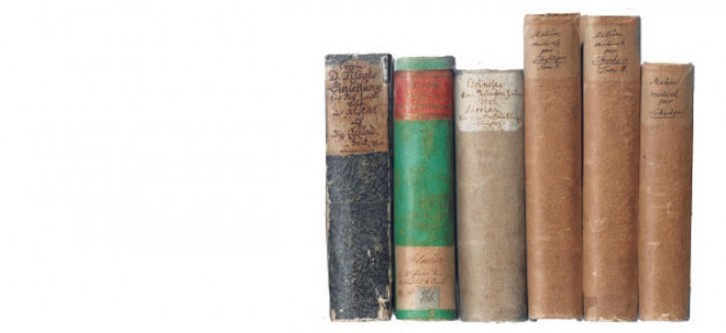












.jpg)

